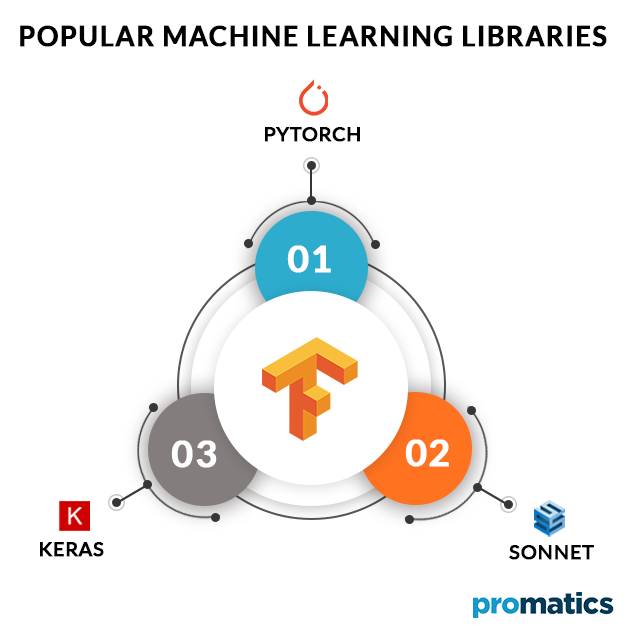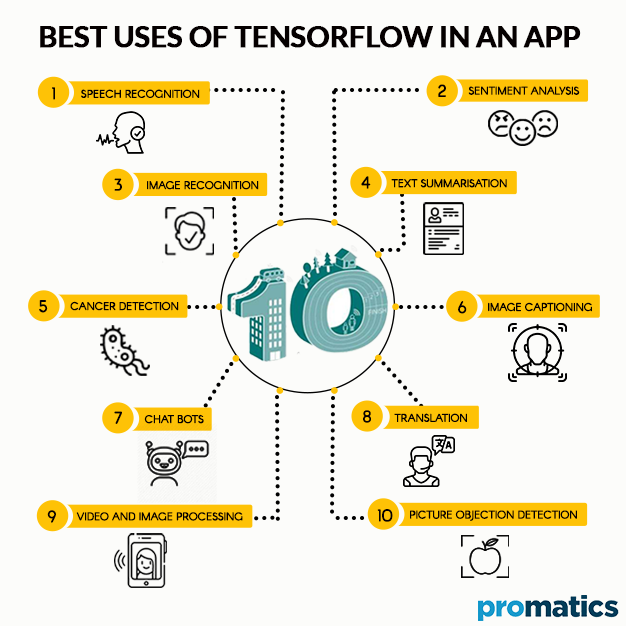How TensorFlow can transform your app into a Superapp?
Artificial Intelligence is here
Machine learning methods based on artificial neural networks are fast becoming the norm with high end programing activities and work. Early restricted to research applications alone deep learning or hierarchical learning is fast being adopted by tech companies in day to day work. We have seen enormous use of machine learning algorithms that run in the backend today powering some of the most famous apps and software we use. It is because of them we are seeing intelligent systems that can predict effectively what will happen next. For instance you are typing and have activated auto keyboard it throws up potential words that you will use next. Who does that happen? Yes you are right artificial intelligence is already here and now lives between us. So how does that is possible. How can regular developers build such features in theur apps? The answer is deep learning libraries.
What is TensorFlow?
To define TensorFlow, developers explain that it is an open-source AI library. It uses data flow graphs to build models. Distinct USP of TensorFlow is that it allows developers to build highly scalable neural networks with multiple layers. The library is put to use when an app development project requires classification, perception, understanding, prediction and creation. App developers can build computational graphs with free additional modules that make AI/ML software development easier for mobile apps. To use TensorFlow, the team of app developers need to be well-versed in Python or C++. TensorFlow can also be termed as a software package for the mathematical manipulation, storage, and transfer of tensors, a generalization of the concept of matrices.
When it comes to TensorFlow, all the computations involve tensors. A tensor is essentially a vector or matrix of n-dimensions that represents all types of data. It is important to note that all values in a tensor hold identical data type with a known shape. The shape of the data is the dimensionality of the matrix or array. Tensorflow takes input as a multidimensional array called tensors. Developers can construct a sort of flowchart of operations (called a Graph) that they want to perform on that input. Here, all the operations are executed inside a graph. The graph can be defined as a set of computation that takes place successively. Further, each operation is called an op node and are connected to each other. In the process, the input goes in at one end, and flows through this system of multiple operations and comes out the other end as output. This is why it was named TensorFlow, the tensor goes into it flows through a list of operations, and then it comes out the other side.
Deep Learning is a popular Machine Learning algorithm which saw a massive upsurge in its adoption in recent past. Google recognised the positives of using deep neural networks to enhance its service base. The company then launched TensorFlow, a framework that allows researchers and web/mobile developers to collaborate and work on an AI model. As the model was developed and scaled considerably, it was made available for common use under Apache Open Source license. As of today the framework can be used, modified, redistributed conditionally.
Touted as the best library available because it is easily accessible for everyone. Not only does it incorporate different API to build easily scalable deep learning architectures but it also allows the developer to visualize the construction of the neural network with Tensorboard.
There are three layers to TensorFlow library:
a.) High-level libraries: Python, TensorBoard, Java, and more.
b.) TensorFlow core: Neural net ops, graph execution engine, and more.
c.) Platforms: CPUs, GPUs, TPUs, Android, and iOS across all major operating systems.
TensorFlow Architecture
TensorFlow architecture can be easily segregated into three parts:
I.) Data Preprocessing
II.) Model Building
III.) Model Training and Estimation
The era of TensorFlow 2.0
TensorFlow employed a graph and session-based approach that required developers to first define a static graph than establish a session to run the graph. Not only did it lead to more re-used boilerplate code, but it also obviated the use of normal Python flow control.
TensorFlow 2.0 is launched to address such shortcomings of the original TensorFlow. The 2.0 version omits the need to pre-define a static graph, initialize sessions, or cater to tensors falling outside of the proper scope. All in all, TensorFlow 2.0 offers a streamlined experience. It promises:
- Reduced redundancy
- Wholesome Keras integration, a high-level Application Programming Interface (API)
- Shift from static graphs to eager execution.
Popular Machine Learning Libraries & How they Rank Against Each Other
Here are some of the most popular machine learning libraries being used in app development:
A.) PyTorch
A popular software tool for deep learning, PyTorch framework is a product of Facebook services. The PyTorch library operates with a dynamically updated graph that allows developers to efficiently make changes to the architecture in the process. It allows the use of standard debuggers, for example, PDB or PyCharm.
PyTorch also supports the data parallelism and distributed learning model. The framework also contains many pre-trained models. The developer maintains that it is well-suited for small projects and prototyping.
However, cross-platform solutions work well with TensorFlow. Caffe2 mobile framework is also a fair choice for similar projects.
B.) Sonnet
Sonnet is another popular deep learning framework built on top of TensorFlow. It facilitates the design of neural networks with complex architecture. It is essentially a high-level object-oriented library that helps with the making of primary Python objects corresponding to a specific part of the neural network. The objects that are developed are independently connected to the computational TensorFlow graph. Conclusively, Sonnet is a flexible functional abstractions tool that is absolutely a worthy opponent for TF and PyTorch.
C.) Keras
Keras is a machine learning framework suitable for projects that feature a lot of data and require deep learning integration. It is a high-level API on top of other popular lower-level libraries. When using Keras, prototyping here is facilitated to the limit. Creating massive models of deep learning is reduced to single-line functions with Keras. Suitable for beginners, it serves ideal for learning and prototyping simple concepts. With Keras outcome is more readable and succinct code. Keras is on the higher Level than TensorFlow.
How Tensorflow Can be Used in Apps?
Here is a concise list of functionalities that you can enhance your mobile app with, thanks to TensorFlow:
a.) Speech Recognition
b.) Image Recognition
c.) Sentiment Analysis
d.) Text Summarisation
e.) Video and Image Processing
f.) Translation
g.) Picture Objection Detection
h.) Chat Bots
i.) Image Captioning
j.) Cancer Detection
How TensorFlow Can Help Your App Become a SuperApp?
The transition of an app into a Super App needs to be a strategic and timely process. Start with a basic app with great UX that allows the app to enjoy great conversion rates. As the users begin to buy-in, integrate TensorFlow to add multiple services to the platform and use them to gain customer’s absolute loyalty. After you are done serving direct offerings, think about opening the app interface to third-party companies to enhance the bundle of services being offered to your customers. All these numerous products and services are to be hosted on a singular app which is magnanimous in stature and aptly ascribed as a Super App. As you expand your app interface to become a super app make sure you minimize the time consumed to complete different tasks in lieu to escalate productivity.
Ideas for Apps that Can be Built Using Tensorflow
Predictive analysis that scores large sums of data with TensorFlow, can help businesses with apps that feature real-time functions. Configuring non-linear relationships from past data slabs and comparing them with endless possibilities of future allows TensorFlow to make probabilistic predictions. The framework allows the use of statistics, modelling, data mining and artificial intelligence to make avant-garde apps. Here is a brief preview of the possibilities it heralds for enterprises in the immediate future.
I.) Healthcare and Pharma Industry
There is a pressing need for apps that can detect disease patterns in new patients under-diagnosis. Apps that use machine learning algorithms on medical datasets make it is possible to find patients exhibiting similar characteristics. Secondly, by the use of cluster analysis and scoring models a kind of predictive modelling, it becomes possible to predict suitable personalised treatment paths for individuals. Apps that recommend personalised drug plans can improve treatment success rates. Mobile apps can be developed to accurately predict how many days a patient may stay under treatment and can allocate resources optimally at the treatment facility.
II.) Food Industry
Mobile App Technology with TensorFlow can use predictive analysis to perform demand prediction, crop health prediction and even yield prediction. Using apps to detect possible plant diseases, support strategic sowing decisions can maximize chances of a favourable outcome. We are in need of apps that predetermine quarterly and annual yield for crops by counting in data on weather and agriculture. TensorFlow can help us build apps that forecast demand and supply for crops in advance
III.) Banking & Finance Industry
TensorFlow’s predictive analysis can be used to predict stock prices based on an analysis of the past performance of stocks. Market sentiment analysis apps are the need of the hour. We could also use apps that detect and prevent suspicious manipulation of stock prices by discovering inappropriate patterns of buying and selling. TensorFlow apps with pattern recognition may also bring to light financial frauds like tax evasion and fraudulent transactions in real-time.
Still have your concerns?
Your concerns are legit, and we know how to deal with them. Hook us up for a discussion, no strings attached, and we will show how we can add value to your operations!


